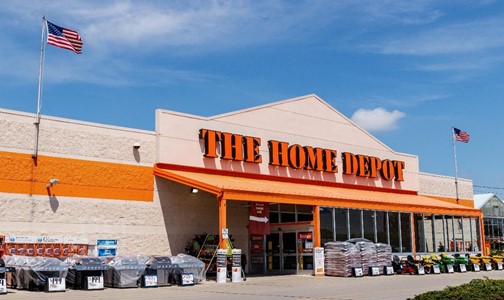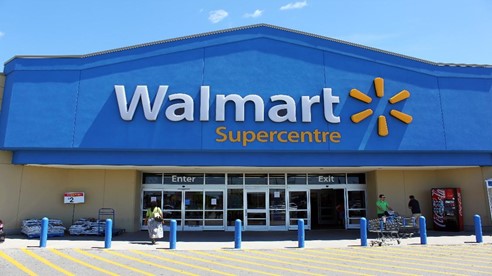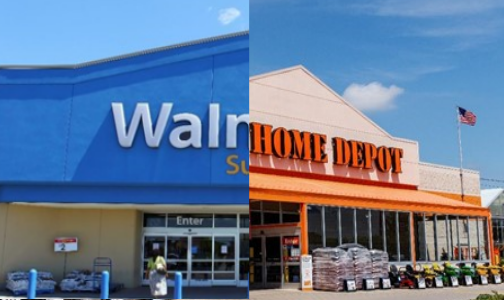Two of the World’s largest retailers, Home Depot (HD) and Wal-Mart (WMT) posted first-quarter results.
The earnings and price action reflect a divergence. HD shares rallied after a nice top and bottom-line beat. WMT is under pressure after it missed bottom-line expectations.
The results will raise questions about consumer habits. A closer look suggests the divergence may not be as wide as headlines suggest.
As the saying goes, things are never as good or bad as they look.

The Home Depot Numbers…
HD reported the highest first-quarter sales in the company’s history. The results were impressive given the slow Spring start due to poor weather. Revenues increased 3.8% y/y to $38.9 billion against the stimulus-assisted 1Q21. Market participants were expecting $36.8 billion.
Comparable sales increased 2.2% (U.S. comps increased 1.7%). This outpaced expectations for a -3% decline in overall comps. In a note ahead of this report, J.P. Morgan suggested inflation could provide as much as a 200-basis point pop to these figures.
These top-line figures decelerated from revenue growth of 10.7 and a comp rise of 8.1% in the prior quarter. Investors will look past this due to the tougher prior year comps as investors were flush with stimulus checks.
Net earnings for Q1 were $4.2 billion or $4.09 per share, well ahead of the expected $3.69. This was up 6% from the prior-year period. The Q4 EPS growth was 21%.
Gross Margins were 33.7%, in line with expectations.
Customer transactions declined -8.2% to 410 million. This marked the second straight y/y decline in transactions as the Q4 number was down -3.4%. However, the Average Ticket jumped 11.4% y/y to $91.72. It was up approximately 9% sequentially, highlighting the inflationary pressures out in the market.
The Average Ticket jump is important as there were fears that falling consumer demand, elevated inventory levels, and poor Spring weather would force both HD and Lowe’s (LOW) to markdown goods.
The company raised its 2022 guidance. Total sales and comparable sales growth are expected to be 3.0%. The prior outlook was for sales growth to be “slightly positive”. The number suggests management feels more confident about consumer spend.
FY22 Operating Margins is expected to be 15.4%. The prior outlook was for this to be flat. The improved margin outlook highlights the strong performance investors have grown accustomed to from HD.
Diluted earnings per share growth are projected to be in the mid-single digits. Again, improved margins provide a boost as the prior outlook was for EPS to be in the low-single digits.
HD has done a great job keeping inventory on the shelf. Inventories were $25.2 billion, a 29% increase from the prior year. This will lighten the blow from potential supply chain issues around China’s COVID shutdown policies.
… and the case of Wal-Mart.

Wal-Mart (WMT) posted earnings of $1.30 per share, 18 cents lower than expectations. Revenues increased 2.4% y/y to $141.6 billion which did outpace the expectations of $138 million.
WMT comp-store sales grew 3% y/y and 9% on a two-year stack. eCommerce growth was 1% and 38% on the two-year stack.
WMT’s International Sales fell 13% y/y to $23.8 billion. These results were negatively impacted by a $5.0 billion divestiture. There was also a negative impact from FX of $400 million. The strong dollar will continue to weigh on multinational margins.
As we can see, sales were respectable. The company continued to gain share in grocery. Inflation lifted the average ticket and the company’s transaction count was up y/y, suggesting customers see WMT as a value play in the inflationary environment.
The problem for WMT was on the bottom line. Operating income fell -23% year-over-year to $5.3 billion.
Consolidated gross profit fell 87 basis points primarily due to Sam’s Club and 38 bps in Walmart U.S. on elevated supply chain costs and product mix. Consolidated operating expenses as a percentage of net sales increased 455 bps, primarily due to increased wage costs in Walmart U.S.
The SG&A rate was up 95 bps primarily due to increased wages related to last year’s hourly wage investments and associates returning from covid leave more rapidly than anticipated.
Fuel ran higher and faster than expected before it could pass on this price. It intends to improve on managing this dynamic in Q2.
Inventory ran higher than expected, increasing 32% y/y. However, just like HD, the company will be able to keep its shelves stocked. It will need to mark down some products which will weigh on the bottom line, but it should allow WMT to continue to gain market share in the current environment.
Management stated that Q2 sales are off to a strong start which the company believes reinforces wins in a tough environment. The bottom line will remain under some pressure. The company lowered its Q2 Consolidating operating income and EPS outlooks to “flat to up slightly” from an increase in the mid-single digits.
It increased its full-year outlook, WMT expects Consolidated net sales to increase 4.5-5%, excluding divestitures compared to the prior outlook of 4%. It sees comp sales growth of 3.5% compared to 3% in its February outlook.
Consolidated operating income is expected to decrease 1% compared to the prior outlook of +3%.
EPS is forecast to decline -1% after WMT thought it would increase in the mid-single digits back in February. The Capital Expenditure outlook remains unchanged as WMT plans to spend on supply chains, automation, customer-facing initiatives, and technology.
The Final Word
There are bound to be stories about how HD blew out results while WMT tripped. A deeper dive into the figures tell a slightly different story.
HD posted a solid round of results. The management team is known for operating efficiently in a difficult environment. Expectations were lower for the HD due to headwinds it faced but it was able to push through these and post another good report.
HD trades at a reasonable 17x forward earnings. The stock is down 28% in 2022. These results suggest a bounce could be in the works. The key will be if the stock can get back above the April highs around $320.
Wal-Mart will be under more scrutiny due to the bottom-line miss. WMT is fighting to keep prices lower so it can garner more market share.
The rise in the Cost of Goods Sold happened faster than WMT expected. WMT operates in the sweet spot for inflation increases (food and gas). Management said the issues were more about the speed of inflation rather than an inability to raise prices.
WMT is a little more expensive as it trades at 20x forward earnings. The stock is slipping back to key support around the $135 area. This sets up a good entry for investors as WMT should continue to gain market share in this tough inflationary environment.
As for the economy, the consumer continues to be in a strong place. We see additional evidence in the strong earnings guidance from United Airlines (UAL) and a beat on April Retail Sales.
These results collectively should help boost this early rally.




